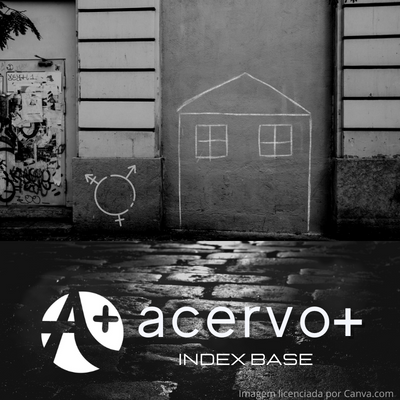Saúde da mulher transgênera em situação de rua
##plugins.themes.bootstrap3.article.main##
Resumo
Objetivo: Identificar a abordagem sobre a saúde das mulheres transgêneras em situação de rua nas produções científicas. Métodos: Revisão integrativa realizada nas seguintes fontes: Scientific Electronic Library Online, Medical Literature Analysis and Retrievel System Online e Biblioteca Virtual de Saúde. Utilizou-se como descritores: “transgender persons”, “health” e “Homeless persons” em português, inglês e espanhol. A pesquisa foi realizada seguindo às recomendações do fluxograma Prisma e suporte do software EndNote Web, submetidos à análise de conteúdo de Bardin. Resultados: 07 artigos que obedeceram aos critérios de inclusão e exclusão, no qual a vulnerabilidade social e seu impacto à saúde se mostrou mediante a falta de habitação, vivência de violências físicas e verbais e exclusão social. Considerações Finais: Essa revisão integrativa abordou majoritariamente a vulnerabilidade e a discriminação interseccional relacionados ao tema da saúde da mulher transgênera em situação de rua, sendo necessário estratégias de cuidado, oferecendo assim a essas mulheres meios para que tenham a oportunidade de uma vida saudável.
##plugins.themes.bootstrap3.article.details##
Copyright © | Todos os direitos reservados.
A revista detém os direitos autorais exclusivos de publicação deste artigo nos termos da lei 9610/98.
Reprodução parcial
É livre o uso de partes do texto, figuras e questionário do artigo, sendo obrigatória a citação dos autores e revista.
Reprodução total
É expressamente proibida, devendo ser autorizada pela revista.
Referências
2. ALMEIDA FILHO NA. O que é saúde? Rio de janeiro: Editora Fiocruz; 2018; 160p.
3. BARDIN L. Análise de Conteúdo. Lisboa, Portugal: Edições 70; 2016; 279p.
4. BELTRAN T, et al. Intersectional Discrimination Is Associated with Housing Instability among Trans Women Living in the San Francisco Bay Area. Int J Environ Res Public Health, 2019; 16(22).
5. BRASIL. Ministério da Mulher, da Família e dos Direitos Humanos. Conselho Nacional dos Direitos Humanos. Resolução Nº 40, de 13 de outubro de 2020. Dispõe sobre as diretrizes para promoção, proteção, e defesa dos direitos humanos das pessoas em situação de rua, de acordo com a Política Nacional para População em Situação de Rua. Brasília (DF): Ministério da Mulher, da Família e dos Direitos Humanos. Conselho Nacional dos Direitos Humanos; 2020.
6. BRASIL. Prefeitura Municipal de São Paulo. Prefeitura Municipal de São Paulo, Secretaria de Assistência e Desenvolvimento Social. Pesquisa censitária da população em situação de rua, caracterização socioeconômica da população adulta em situação de rua e relatório temático de identificação das necessidades desta população na cidade de São Paulo. São Paulo (SP): Prefeitura Municipal de São Paulo; 2019.
7. DIAS ALF, et al. On the fringes of the city: invisibility paths and exclusion of transvestites on the street. Gerais: Rev Interinst Psicol., 2015; 8: 214-233.
8. EASTWOOD EA, et al. Young Transgender Women of Color: Homelessness, Poverty, Childhood Sexual Abuse and Implications for HIV Care. AIDS Behav., 25(Suppl 1): 96-106.
9. FLENTJE A, et al. Mental and Physical Health among Homeless Sexual and Gender Minorities in a Major Urban US City. J Urban Health, 2016; 93(6): 997-1009.
10. GLICK JL, et al. "Housing Insecurity Seems to Almost Go Hand in Hand with Being Trans": Housing Stress among Transgender and Gender Non-conforming Individuals in New Orleans. J Urban Health, 2019; 96(5): 751-759.
11. JAMES SE, et al. The report of the 2015 U.S. transgender survey. Washington, DC: National Center for Transgender Equality; 2016.
12. JESUS JG. Orientações sobre a população transgênero: conceitos e termos. Brasília: Autor; 2012. 24p.
13. JESUS JG. Transfeminismo: Teorias e Práticas. Rio de Janeiro: Editora Metanoia; 2015. 206p.
14. JOHNS EA, et al. Sociodemographic Factors Associated With Trans female Youth's Access to Health Care in the San Francisco Bay Area. J Adolesc Health, 2017; 61(2) :259-261.
15. KULICK D. Travesti: prostituição, sexo, gênero e cultura no Brasil. Rio de Janeiro: Fiocruz; 2008. 280p.
16. LUCENA SG. Análise da passabilidade como mecanismo de proteção as experiências trans. E-book CONQUEER... Campina Grande: Realize Editora. 2018; 156-156.
17. LYONS T, et al. Experiences of Trans Women andTwo-Spirit Persons Accessing Women-Specific Health and Housing Services in a Downtown Neighborhood of Vancouver, Canada. LGBT Health, 2016; 3(5): 373-378.
18. MENDES KDS, et al. Revisão integrativa: método de pesquisa para a incorporação de evidências na saúde e na enfermagem. Texto contexto -enferm., Florianópolis, 2008; 17(4): 758-764.
19. MENDES LG, et al. Social protection and production of care for transvestites and transgender women in homeless situation in the city of Belo Horizonte (MG). Saúde em Debate, 2019; 43(8): 107-119.
20. OLIVEIRA MRG. “Transexistências negras: O lugar de travestis e mulheres transexuais negras no Brasil e em África até o século XIX”. In: Ribeiro PRC, Magalhães JC, Seffner F, Vilaça T. Corpo, gênero e sexualidade: resistência e ocupa(ações) nos espaços de educação. Rio Grande: EDFURG; 2018.
21. PEREIRA LI e MATTOS DL. Somos humanos na rua, não somos lixo": análise da Política Nacional para a Pessoa em Situação de Rua e o caso do município do Rio de Janeiro. Rev Programa Pós-Grad Direito UFC, 2019; 39(1): 243-64.
22. SIQUEIRA GC, et al. Mulheres transexuais e travestis negras: vulnerabilidade, preconceito e discriminação. Debates en Sociología, 2021; 52: 43-57.
23. SOUZA ES e TANAKA LH. Healthcare: action research with trans people living on the streets. Rev Bras Enferm., 2022; 75(Suppl 2): e20210016.

